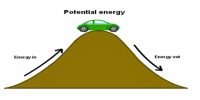Heat is a kind of energy which creates the sensation of hotness and coldness. Heat flows from hotter to colder bodies. Therefore the energy that transfers from one body to another due to the difference of temperature is called heat.
The molecules of a substance always remain in the state of vibratory motion. So they possess kinetic energy. The total amount of energy of a substance is directly proportional to the sum of the kinetic energy of the molecules constituting the substance. When heat is applied to a body the motion of the molecules increases and as a result the kinetic energy of the molecules increases.
Unit of Heat: In SI system the unit of heat is joule (J). Earlier the unit of heat used to be calorie (Cal). The relation between joule and calorie is 1Cal = 4.2 J.
Experimental Task: Label three containers A, B, C kept on the table. Take water at room temperature in container A and take reasonably hot water (that your hand can tolerate) in container C. Mix some amount of hot water and water at room temperature in the container B. Now dip your right hand in the container A and left hand in the container C. After one minute bring out both hands and immerse both hands at the same time in the container B. What are the feelings of your two hands?
Water at a certain temperature is in the container B, yet hotness will be felt by the right hand and coldness by the left hand. Because the water in which the right hand was immersed previously was at a lower temperature than the water contained in B. Similarly coldness will be felt by the left hand because the water in which the left hand was immersed previously was at a higher temperature than the water contained in B.












